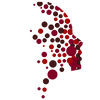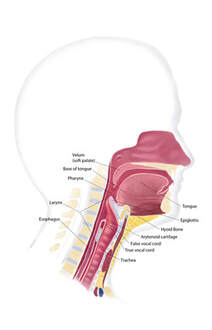Swallowing is a complex and coordinated activity that requires various muscle groups and other structures, including the larynx, to function in a swift and coordinated manner. When this doesn’t happen properly, it can result in food or liquid falling into the trachea, known as “aspiration.” This is what happens when a person chokes.
To briefly describe a normal swallow, of course it begins in the mouth. This is referred to as the oral phase of swallowing. During this phase, you chew any solid food and your tongue works in coordination with your lips and cheeks to organize the material in your mouth and move it, all together, to the back of the mouth, or the oropharynx, where the mouth joins the throat.
Once this happens, the pharyngeal phase of swallowing occurs. During this phase is when much of the work of swallowing is accomplished.
The tongue base pushes backward and downward, making contact with the superior pharyngeal constrictors. These are the highest muscles in the throat. This begins the downward movement of the food material toward the esophagus. As this happens, material fills the vallecula. This is a “pocket” in your throat created on one side by the tongue base and by the epiglottis on the other side.
As the tongue base pushes downward, the pharyngeal constrictors begin to contract, like a purse string, from the top of your throat downward in a wavelike manner. At the same time, muscles connected to the larynx and hyoid bone, pull the larynx upward and slightly forward. The vocal cords also close during this to protect the windpipe from food going in.
The closing of the vocal cords also plays a very important role in the swallow process. By closing, they prevent any air from leaving the lungs during the swallow. This subglottic pressure is important for driving a strong swallow.
As the larynx moves upward, two other very important things happen. The epiglottis flips backward or retroflexes over the opening to the larynx, like a lid covering the larynx and trachea during the swallow. While this helps to protect the airway from food material entering, it also allows for the tongue base to now clear the food out of the vallecula. As the epiglottis flips backward, the vallecular pocket turns into a smooth slide, deflecting the food material past the protected larynx and downward toward the esophagus.
Another important action happens when the larynx moves upward and forward during the swallow. This action also pulls open the cricopharyngeus, or “upper esophageal sphincter” which remains closed except during swallowing, burping or vomiting. This is a small muscle at the top of the esophagus that opens to allow food and liquid to pass, then closes to prevent reflux or regurgitation back into the throat. At rest, the cricopharyngeus is closed.
The entire time, the pharyngeal constrictors work in conjunction with these other actions, squeezing in a purse string manner from top to bottom. The middle pharyngeal constrictors are active when moving the food past the larynx. The inferior pharyngeal constrictors help to squeeze the food material past the cricopharyngeus and into the esophagus.
Once into the esophagus, the Esophageal Phase of swallowing begins. The esophagus is a tube like muscular structure that squeezes from the top downward in a wavelike manner called peristalsis. This action is what moves the food into your stomach.
To briefly describe a normal swallow, of course it begins in the mouth. This is referred to as the oral phase of swallowing. During this phase, you chew any solid food and your tongue works in coordination with your lips and cheeks to organize the material in your mouth and move it, all together, to the back of the mouth, or the oropharynx, where the mouth joins the throat.
Once this happens, the pharyngeal phase of swallowing occurs. During this phase is when much of the work of swallowing is accomplished.
The tongue base pushes backward and downward, making contact with the superior pharyngeal constrictors. These are the highest muscles in the throat. This begins the downward movement of the food material toward the esophagus. As this happens, material fills the vallecula. This is a “pocket” in your throat created on one side by the tongue base and by the epiglottis on the other side.
As the tongue base pushes downward, the pharyngeal constrictors begin to contract, like a purse string, from the top of your throat downward in a wavelike manner. At the same time, muscles connected to the larynx and hyoid bone, pull the larynx upward and slightly forward. The vocal cords also close during this to protect the windpipe from food going in.
The closing of the vocal cords also plays a very important role in the swallow process. By closing, they prevent any air from leaving the lungs during the swallow. This subglottic pressure is important for driving a strong swallow.
As the larynx moves upward, two other very important things happen. The epiglottis flips backward or retroflexes over the opening to the larynx, like a lid covering the larynx and trachea during the swallow. While this helps to protect the airway from food material entering, it also allows for the tongue base to now clear the food out of the vallecula. As the epiglottis flips backward, the vallecular pocket turns into a smooth slide, deflecting the food material past the protected larynx and downward toward the esophagus.
Another important action happens when the larynx moves upward and forward during the swallow. This action also pulls open the cricopharyngeus, or “upper esophageal sphincter” which remains closed except during swallowing, burping or vomiting. This is a small muscle at the top of the esophagus that opens to allow food and liquid to pass, then closes to prevent reflux or regurgitation back into the throat. At rest, the cricopharyngeus is closed.
The entire time, the pharyngeal constrictors work in conjunction with these other actions, squeezing in a purse string manner from top to bottom. The middle pharyngeal constrictors are active when moving the food past the larynx. The inferior pharyngeal constrictors help to squeeze the food material past the cricopharyngeus and into the esophagus.
Once into the esophagus, the Esophageal Phase of swallowing begins. The esophagus is a tube like muscular structure that squeezes from the top downward in a wavelike manner called peristalsis. This action is what moves the food into your stomach.


